There is a growing hunger among many white people to understand the anger and despair that African Americans face. Whatever misunderstandings we may have, more empathy for the experiences and history of others can’t hurt. Indeed, it might help in the most important ways, on the most sensitive questions—including finding greater compassion, the one thing in shorter supply than almost anything else today.
How can empathy and compassion be developed? Since January 2018, I have been reading to try to understand more about the experiences of African Americans, as I am a privileged white girl who spent her childhood in segregated neighborhoods in Texas and California. I haven’t had the opportunity to get to know many people of color or to appreciate their history as part of our shared American story beyond what I learned in school, which wasn’t much. These books have really opened my eyes to the struggles of African Americans, especially since the end of the Civil War, when things were supposed to get better with the abolition of the satanic institution of slavery but did not. (Things got better in many ways, but taints of slavery remain).
the solution to the problems outlined in these books was given to us by Jesus Christ
I wish that we could change the aspects of our systems that undermine the lives of poor people of all races, and those that intentionally (or unintentionally) discriminate against African Americans and other people of color. And we must change our hearts and minds to see those in need as people we should help—not merely as people who aren’t trying hard enough (see Mosiah 4:16-21). The idea that anyone who isn’t succeeding is a slacker or is trying to take advantage of the system is a false narrative promoted by people who don’t understand that we are all just one bad day away from losing everything. If any good thing can come out of the COVID-19 pandemic, it would be that understanding. These books are listed in the order I read them; reviews are those I posted on goodreads.com after finishing each book. I know that you can’t learn everything by reading (although I try), but this is a beginning. There are many more books on my to-read list that are, no doubt, as valuable as these. The point is to start trying to learn more.
My own belief is that the solution to the problems outlined in these books was given to us by Jesus Christ, who asked us to treat others as we would want to be treated (Matthew 7:12) and to love our neighbors (and every person is our neighbor) as we do ourselves and those we already love (Luke 10:25–37). As best we can, we should do this through our political and social choices as well as our actions toward individuals.
I continue to feel sorrow, anger, and an ever-growing need and hope that somehow, someday, the horrible wounds of racism and injustice can be healed as we seek to build Zion. As the prophet Nephi taught in 2 Nephi 26:33:
The Lord … doeth that which is good among the children of men; and … he inviteth them all to come unto him and partake of his goodness; and he denieth none that come unto him, black and white, bond and free, male and female; and he remembereth the heathen; and all are alike unto God, both Jew and Gentile.
Editor’s note: Some of the texts reviewed below have been written off by critics on the political right as having nothing useful to offer beyond progressive talking points. In the spirit of listening deeply and seeking to hear what’s in the hearts of others, Hawkins’s challenge to consider these influential texts feels valuable–especially in a day when more and more refuse to do that.
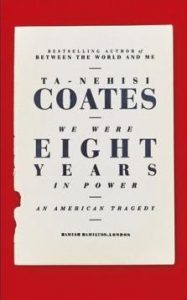
Ta-Nehisi Coates, We Were Eight Years in Power: An American Tragedy, 2017.
This is one of the most important books I have ever read—helping me understand the depth of the discrimination, the tragedy, the systemic aspects of our history and culture that have held people back, and the depth of anger that so many people feel about how African Americans have been treated, intentionally and unintentionally, for 400 years and counting. The writer has made me think about how I approach history and the world, and how lacking my education has been in this regard. Although he writes in the context of the years from the beginning of Barack Obama’s run for the presidency to the aftermath of the election of Donald Trump, Coates intertwines the histories of slavery, Reconstruction, Jim Crow, the New Deal, the creation of ghettos through segregation and redlining, the Civil Rights movement, and the so-called law-and-order and welfare reforms that have resulted in undermining black family life and the mass incarceration of black men. (All important contexts for people of faith who rightly value the power of family life—but who don’t always consider some of the larger influences that can undermine that precious home life.) Coates also shares the stories of his life that have led him where he is now, as a respected and talented writer for The Atlantic and other publications. Coates is not ranting—he persuasively cites sources and explains why he thinks as he does and how his opinions have been shaped. And he makes suggestions about what can be done. Eye-and mind-opening and highly recommended.
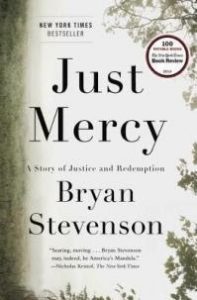
Bryan Stevenson, Just Mercy: A Story of Justice and Redemption, 2014.
This is a heartbreaking, important book. The author and other lawyers and associates of the Equal Justice Initiative have been providing legal services on behalf of the falsely convicted—those whose trials have been so tainted by racial bias or lack of effective representation that they were essentially farcical. They also help those condemned to death in prison (formally or effectively), who committed their crimes when they were minors or who committed nonviolent crimes, and others whom the justice system has failed spectacularly. There are many others who should be helped and cannot be for lack of resources. In both subtle and dramatic ways, the American justice system has been undermined by racial discrimination stemming from slavery and continuing in the terrorism of the Klan and the institution of white supremacy after Reconstruction; the conviction of African Americans of minor or created crimes so that their labor could be sold to businesses (slavery by another name); the Jim Crow laws; and mass incarceration. This book brings all this to a personal level with the stories of falsely convicted people and others the author worked to free in Alabama, then later throughout the United States through the Equal Justice Initiative.
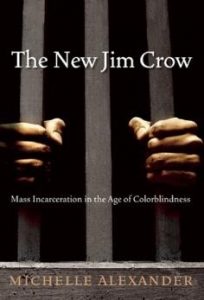
Michele Alexander, The New Jim Crow: Mass Incarceration in the Age of Colorblindness, 2010.
This important book should be required reading in law school and law enforcement academies. It should be read by every defense attorney (public defender or private practice), prosecutor, and all those working in law enforcement and the correctional system. After first controlling black people (even free black people) via slavery, America’s Jim Crow policies instituted a new kind of control. Later, the War on Drugs profoundly shaped the black community by increasing rates of policing and incarceration. Although the provisions of drug enforcement laws appear to be race-neutral, they have too often perpetuated a permanent underclass of African Americans and, to a lesser extent, Latinos. Parallel to Jim Crow imposed at the end of slavery, the War on Drugs was imposed after the passage of the Civil Rights Act in order to appease (especially Southern) working-class and poor white people whose votes the powerful wanted to attract by being “tough on crime.” This has resulted in the mass incarceration (including a post-incarceration shadowland of unemployment, housing insecurity, fines, and ineligibility for benefits) of an alarming number of black men and has had deep negative effects for their families and neighborhoods. Because of harsh police and prosecutorial practices, lengthy sentences for possession of small amounts of drugs such as marijuana and crack cocaine, and mandatory minimum sentences, the U.S. prison system has become a financial investment for private and government entities. This has had devastating consequences for African American communities and the inner-city ghettos that were initially created by discriminatory housing practices during the Jim Crow era. The author makes the case that amounts and types of drugs that are commonly used by white high school and college students are overlooked or lightly punished by law enforcement, but the same drugs when used or sold by young people of color result in felony records and lengthy, even lifelong, prison sentences. The people working in law enforcement and mass incarceration systems are not intentionally racist or biased for the most part. But our country’s attempts to create a color-blind or race-neutral society, including U.S. Supreme Court decisions that refuse to look at the effects rather than the causes of police and prosecutorial practices, have resulted in devastating outcomes for communities and individuals of color that arguably can be fully overcome only by systems-level reforms and improvements (along with, of course, the needed softening of hearts). We should not be color-blind, but instead should be race-conscious and caring so as to alleviate the continuing shackles that metaphorically enslave so many African Americans. The author has done her research and makes a convincing case; the book is well-referenced.
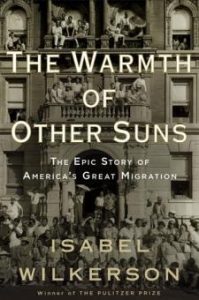 Isabel Wilkerson, The Warmth of Other Suns: The Epic Story of America’s Great Migration, 2010.
Isabel Wilkerson, The Warmth of Other Suns: The Epic Story of America’s Great Migration, 2010.
This has got to be the definitive work on the Great Migration (which I think of as the “Great Escape”) of African Americans from the South to the North after the promises of Reconstruction failed miserably in the South. That failure began about 1870; the migration lasted until about 1975; an imperfect redemption was attempted with the Civil Rights Act of 1964—and the imperfections last through the present day. The author focuses on three people who embarked on the Great Migration in different decades, from different homes and situations, and who ended up in different places: Los Angeles, New York City, and Chicago. She follows them throughout their lives, describing what their lives were like in the South, how they managed to leave, and how their lives were up North. Wilkerson also gives more general history as background for the three focus stories and addresses the social-scientific thinking about the Great Migration as it has evolved. The author spent hundreds, if not thousands, of hours interviewing and spending time with many people and their families who migrated as well as those who stayed in the South. This is a formidable work, and in its quest to be definitive, sometimes seems to drag a bit. But it is a great accomplishment as a record of life in the United States, and of course, the disappointing fact that the migrants met with almost as much ill-treatment in the North and West as they did in the South, which led to the urban ghettos, poverty, crime, drug abuse, and other problems whose roots can to a great degree be traced to the failure of white Americans to accept the humanity of black Americans. Very interesting is the author’s comparison of black migrants to immigrants of other cultures and countries who migrated to American cities and initially were also treated poorly by more-established folk. These German and Irish and Italian immigrants eventually were accepted because they could adapt culturally and linguistically while bringing the richness of their own languages and cultures to the American “melting pot” (actually more a tossed salad). Black Americans, however, were not allowed in the same way to adapt and be accepted as part of the majority culture because their skin color always marked them as the “other.” Yet they still accomplished so much and enriched American life through music, writing, humor, language, dance, activism, and in many other ways. Despite the new problems that migrating North out of the post-Reconstruction South brought to the lives of black migrants and their families, few would have preferred to remain in the South. Wilkerson explores the bittersweetness and the outrage of this history carefully and well.
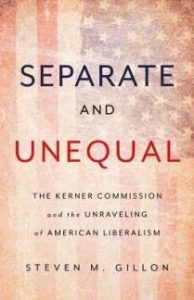
Steven M. Gillon, Separate and Unequal: The Kerner Commission and the Unraveling of American Liberalism, 2018.
You would not think that a book about the work of a commission on the inner-city riots in the summer of 1967 would be that interesting, but this book is almost a page-turner, and it really puts things in perspective. When President Lyndon B. Johnson muscled Congress into passing the Civil Rights Act in 1964 (in part by allowing Southern segregationists to add amendments that took out a lot of its teeth), the economy was on the rise and hopes for the Great Society programs were high. The commissioners and staff who investigated the inner-city riots were shocked at conditions in the urban cores—conditions that few people outside those communities were aware of. (Johnson was convinced that the riots showed a lack of gratitude on the part of African Americans for all he had accomplished for them.) Although some commissioners thought that increased attention to law and order was the answer, it turned out that police responses had in almost all cases begun and aggravated the intensity of the riots. And the report of the commission argued white racism was the underlying cause of the conditions that led to the riots. On this basis, leaders ultimately proposed massive federal spending as the answer to many of the problems—along with desegregation of housing and employment in ways that many, if not most, white Americans were unwilling to consider. Spending on the Vietnam War was using up all the funds that might have gone to alleviate the plight of African Americans, even had the political will been present, and the economy took a downturn that further undermined possible funding. The author puts the commission’s work and report in the political and economic contexts of the time, and discusses how and why things have not gotten better, due to the militarization of the police, the War on Drugs, the polarization of the American people through the Republican Southern Strategy that exacerbates racist fears, and other factors. He brings things forward to the Black Lives Matter movement and the partisanship of the electorate and explains how the moment was lost that could have allowed American liberalism to work toward solving some of these problems in the United States.
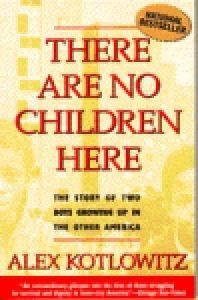
Alex Kotlowitz, There Are No Children Here: The Story of Two Boys Growing Up in the Other America, 1991.
This book tells the story of Lafeyette and Pharoah Rivers, two boys growing up in the “projects” of South Chicago. The author practically lived with the family for a couple of years, as well as doing interviews and research to fill in the blanks, and they let him into their lives to an amazing degree. The value of this book, as compared to books that report on broader aspects of the situations faced by the poor and African American people of the inner city, is that the reader becomes familiar with two boys in one family, their neighbors, and the particular circumstances of their lives, to an almost painful degree. The book was published in 1991, and things have not gotten much better in that area, to my knowledge. The conditions in the high-rise public housing (which has been demolished but not meaningfully replaced) where the boys live with their mother, LaJoe, their triplet sisters, and an ever-changing cast of other relatives are horrific, all crammed into a three-bedroom apartment where very little works as it should and the housing authority doesn’t maintain anything. The drug trafficking and shootings nearby are so frequent that you forget that they are not the background noise of everyone’s life. By witnessing their lives more closely, the reader is helped to appreciate the people in the book as individuals and not “those people”—although they are often still treated as one homogenous group of stereotypes by the city, the housing authority, the social service workers, the police, the juvenile justice authorities, and some schoolteachers and school personnel. The constant struggles not to lose the little they have, to maintain their capacity to feel love and nurture relationships in the family, and to keep some hope for the future are exhausting for them and depressing for the reader. Every bad thing that you can imagine (and some you cannot) seems to happen to these boys or someone they know. The hopelessness of their circumstances is overwhelming, to the point where the thing that brings the reader (although unfortunately not the boys) to remember that there is loveliness in the world occurs in their early teens, when they see for the first time—a rainbow.
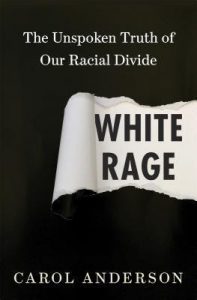
Carol Anderson, White Rage: The Unspoken Truth of Our Racial Divide, 2016.
This book summarizes the undermining of attempts at racial equality in America by white politicians, judges, citizens, and others who struggle in different ways to show equal dignity and humanity to African American people. The author details and footnotes the systemic undermining of attempts to create equality in the United States, beginning with Reconstruction and Jim Crow, with the practices and laws that terrorized black Americans in the South, which led to the Great Migration and segregated those who escaped the South into poor neighborhoods with increasing hopelessness and lack of opportunity throughout the country. She goes on to the Civil Rights movements and laws, the attempted desegregation of schools, the War on Drugs and resulting mass incarceration, and the problematic actions of presidents, lawmakers, and judges in the presidential administrations of Eisenhower through Trump. Although there were some successes in the 1970s, they have been almost completely dismantled by voter suppression, racially motivated gerrymandering, and underlying prejudice that has unfortunately influenced many official actions since before the Civil War until now. The author also points out that attempts to alleviate the inequality of African Americans are sometimes described as “unfair discrimination” against white people, as though our society could hardly be judged as race-neutral or color-blind after centuries of white advantage. Each of the subjects portrayed in the book has been dealt with in more depth by other scholars, but this book is a good summary of what has happened and what might be done now if we could only summon the charity and the political will to undo some of the damage.
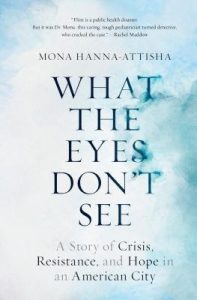
Mona Hanna Attisha, What the Eyes Don’t See: A Story of Crisis, Resistance, and Hope in an American City, 2018.
This book was written by a pediatrician who was a leader in exposing the lead contamination of the water in Flint, Michigan – a place where residents are almost all African American. The story of how the lead contamination happened is combined with the author’s description of her family of origin and their immigration from Iraq to the United States, as well as her husband and daughters and their family, in a pleasing and satisfying way. The resistance of the people in charge to all attempts to expose the disaster of the lead in the water—no level is safe, there is no treatment, and it does terrible neurological damage, especially to unborn children, babies, and little children—is painful to witness. The reader observes how officials covered up their mistakes and resisted accepting responsibility or trying to fix things, resulting in more damage to the vulnerable. Even though the author and others were able to get funding for bottled water and future care for some of those affected, much damage was done and the extent of the damage will never really be known. Her arguments that this constitutes environmental racism are compelling—especially since if this had been happening in Ann Arbor or Grosse Pointe, wealthy majority-white cities, there would have been quicker action, or the problem might not have occurred at all. One minor complaint—the author should have stated much earlier in the book that she and her family were not living in a place that got its water from the Flint system. I kept waiting for her to take action to get bottled water and filters and so on for her family.
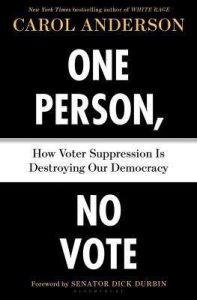
Carol Anderson, One Person, No Vote: How Voter Suppression is Destroying Our Democracy, 2018.
This book underscores the serious reason for concern over voter suppression tactics that have been increasing since the Voting Rights Act was undermined by the U.S. Supreme Court in Shelby County v. Holder (2013). And things were bad enough already. Every eligible American citizen has the right to vote, and yet legislation and practices concerning voter I.D. laws, racial and partisan gerrymandering, purging the voter rolls, and reductions in early voting, polling places, voter registration, and reliable mail-in ballots have undermined the voices of thousands of black, Latino, Asian, and Native American and even white citizens—not only in the Southern states (although some of the worst examples are there), but also in other states across the country. Voter fraud is exceptionally rare, but that possibility has been used to implement these laws and practices and frighten the public when the desire for political power is the truly frightening foundation of these often-racist tactics. People who are concerned about ballot integrity could do more to encourage the Senate to pass laws such as H.R. 2660, the “Election Security Act of 2019,” which have been proposed to fund efforts by the states to ensure the safety of elections, as well as efforts to thwart the attempts of Russia and other countries to undermine the integrity of American elections.
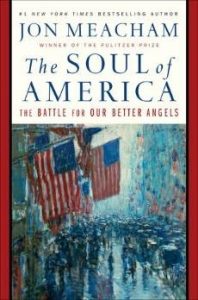
Jon Meacham, The Soul of America: The Battle for Our Better Angels, 2018.
In this great read, Meacham shows important times in American history—the rise of the Ku Klux Klan and the Jim Crow South, the Civil Rights Movement, the McCarthy era—when the actions of a U.S. President, for good or ill, made a huge difference. These were (and are) times when people were afraid, because of integration, or increased immigration from southern Europe, or the freedom of the slaves, and that fear gave rise to populist/nationalist/racist movements. The comparison to the rise of the Trump administration is obvious and Meacham doesn’t belabor it but points it out. This well-written book allows the reader to see important patterns in American history and to appreciate those who did not give in to hatred and cruelty.
The post Deepening Empathy, Compassion, and Understanding Through Reading appeared first on Public Square Magazine.
Continue reading at the original source →



